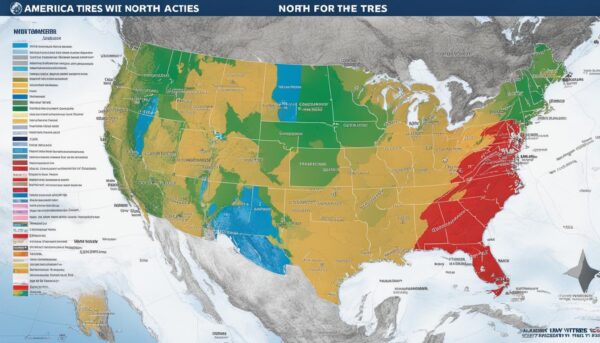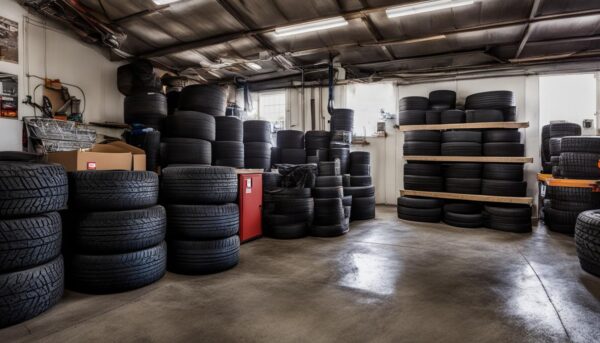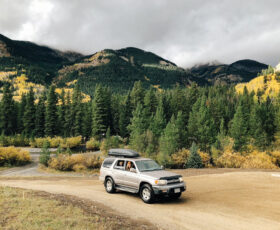Last Updated on 4 months
Elevate Your Winter Journey: Expert Tips for Tire Selection and Safety
Preparing for the unpredictable winter weather is essential for every driver. Investing in a set of winter tires is crucial to ensuring safety and mobility on snow-covered and icy roads. This ultimate winter tire guide provides insights into the benefits of using winter tires, how they enhance your winter driving capabilities, and the top brands available. It’s time to conquer the cold-weather driving challenges with confidence and the correct set of tires!
Key Takeaways
- Winter tires are designed explicitly for cold-weather driving and provide superior traction on snow and ice.
- Understanding the importance of winter tire features, such as tread patterns and rubber compounds, is crucial for safety.
- Properly sizing and selecting top brands can bring substantial benefits and peace of mind during winter’s challenges.
- Legal requirements and recommendations regarding winter tires must be observed where applicable.
- Investing in quality winter tires can save money in the long term and potentially enhance vehicle resale value.
- Proper tire maintenance is essential for longevity and overall performance.
Exploring the Importance of Winter Tires for Snowy Conditions
Winter driving safety tips are crucial for navigating challenging winter road conditions. One critical aspect is understanding the limitations of regular tires and the benefits of winter tires. Drivers must be well-informed about the best tires for icy roads and the importance of winter tire technology in avoiding accidents and ensuring safety.
Why Your Regular Tires Just Won’t Cut It in Winter
When comparing regular tires vs. winter tires, it’s clear why the latter is a superior choice for snowy and icy roads. Common tires, or all-season tires, lack the specialized tread patterns and rubber compounds that flexibly stay soft in cold temperatures, making them inadequate for winter conditions. Conversely, winter tires are designed with deeper treads and distinctive features that effectively improve grip on icy roads and tackle winter’s unpredictability. By switching to winter tires, drivers can significantly reduce the risk of winter accidents, providing them with safety and control during the coldest months.
Winter tires significantly outperform regular tires in terms of traction and grip, making them an essential component of any winter driving safety plan.
The Technology Behind Winter Tires: Ensuring Safety on Icy Roads
Winter tire technology incorporates advanced tread designs and rubber compounds specifically crafted for cold-weather driving. These features work cohesively to ensure maximum safety on icy roads by providing better grip and reduced braking distances compared to all-season tires. The technology behind winter tires is critical in preventing slippage and enhancing stability under harsh winter conditions, making them essential for any winter driving safety plan.
- Deep treads with biting edges for better traction on snow and ice.
- Wide grooves to evacuate snow and slush from the contact patch, minimizing the risk of hydroplaning.
- Flexible rubber compounds that maintain their grip in cold temperatures.
Considering the range of benefits that winter tires offer, such as improved traction, shorter stopping distances, and increased stability, it’s no surprise that these specialized tires are highly recommended for snow-driving tips and icy road safety.
| Features | Regular Tires | Winter Tires |
|---|---|---|
| Tread Patterns | Designed for general use across various weather conditions | Specialized designs with deeper treads for superior grip on snow and ice |
| Rubber Compounds | Hardens in cold temperatures, reducing grip and performance | Remains flexible for consistent traction in freezing conditions |
| Performance on Icy Roads | Less effective, resulting in longer stopping distances and lower overall safety | She was considerably better, providing greater control and reduced risk of accidents. |
In summary, utilizing winter tires during the cold months is crucial to safe driving plans. They provide better performance, traction, and stability in challenging winter conditions.
Winter Tire Features That Keep You Safe in Winter Driving
Winter tires offer distinct advantages in tackling the unique challenges of cold-weather driving. Two essential features that contribute to their superior performance are tread patterns and rubber compounds. Understanding how these features work together to provide better grip and safety can inform your winter tire selection and enhance your overall winter driving experience.
The Science of Tread Patterns: How They Provide Better Grip
Winter tires are engineered with specific tread patterns to increase grip on slippery surfaces like snow and ice. The deeper grooves and sophisticated designs, like snow claws and sipes, improve traction. The strategic tread design is meant to trap and expel snow, which is crucial for winter driving safety and prevents hazardous slippage on slick surfaces.
- Snow Claws are biting edges within the tire’s grooves, providing extra grip during acceleration and braking on snow and ice.
- Sipes: Tiny slits in the tread blocks that increase the number of grip edges, which helps maintain traction on slippery surfaces.
Winter tire tread patterns are specifically designed to effectively trap and expel snow, significantly improving safety and vehicle control in harsh winter conditions.
The Role of Rubber Compounds in Cold Weather Driving
The rubber compounds used in winter tires are another factor critical to their exceptional performance during cold driving. They are designed to remain flexible at low temperatures, which ensures consistent performance and safety. This flexibility allows the tire to conform to the road surface more effectively, offering improved traction and handling even in the most severe winter conditions. Using bio-based cryo crystal grip particles is a modern development in these compounds, enhancing ice traction.
| Compound | Description | Benefits |
|---|---|---|
| Soft Rubber Compounds | These compounds are formulated to stay flexible at low temperatures, enhancing traction in freezing conditions. | Improved grip and handling on snow and ice. |
| Bio-Based Cryo Crystal Grip Particles | These particles are derived from nature-based sources and embedded in the tire’s rubber compound to provide an outstanding grip on ice. | Increased ice traction and environmentally friendly technology. |
Investing in winter tires with advanced tread patterns and rubber compounds can improve your vehicle’s winter performance and provide extra safety during cold driving. Being well-informed about winter tire features is vital for maximizing winter driving confidence and successfully navigating the hazards of snow and ice conditions.
Decoding the Three-Peak Mountain Snowflake Symbol
The Three-Peak Mountain Snowflake Symbol (3PMSF) is a vital certification mark indicating a tire’s ability to handle severe snow conditions and winter driving hazards. This symbol, found on the tire’s sidewall, is a reliable representation of its suitability for winter driving and is crucial for selecting appropriate snow tires.
Tires featuring the 3PMSF symbol have undergone rigorous testing to ensure they meet or exceed the USTMA requirements, offering superior traction and safety in snow and ice. Such certifications play a significant role in protecting drivers from the unpredictable nature of winter roads and addressing the challenges of cold weather.
The Tire and Rubber Association of Canada (TRAC) states that “Tires bearing the Three-Peak Mountain Snowflake Symbol demonstrate improved snow traction of 110 percent or greater when compared to a reference tire as tested per the ASTM F1805 test on packed snow.”
By understanding the meaning and significance of the 3PMSF symbol, drivers can make informed decisions when selecting winter tires and ensure they are well-equipped for adverse driving conditions. When investing in new tires, prioritizing those with the Three-Peak Mountain Snowflake Symbol can significantly improve winter driving safety and performance.
- Recognize the 3PMSF symbol on a tire’s sidewall.
- Ensure your chosen winter tires meet or exceed USTMA requirements.
- Invest in tires with the 3PMSF symbol for a safer winter driving experience.
As well as assuring drivers of a tire’s winter capabilities, the 3PMSF certification represents a commitment by manufacturers to continually improve their tire technology in response to the changing demands of winter road conditions. By choosing winter tires with this certification, drivers can be confident in their ability to navigate even the most challenging snow and ice-covered roads.
When to Make the Switch: Installing Winter Tires Before the Snow Falls
As winter approaches and temperatures consistently fall below 45°F (7°C), it’s crucial to be prepared for driving in snow by transitioning to winter tires. Proper timing for winter tire installation maximizes their performance capabilities and ensures readiness for sudden snowfalls throughout the season.
Monitoring the Temperature: The Best Time for Tire Transition
Winter tires are designed to perform optimally in cold conditions, so monitoring the temperature and switching to these specialized tires when the mercury consistently drops below 45°F (7°C) is essential. Waiting until the snow falls can increase risks and challenges on the road, as driving with all-season or summer tires on icy surfaces can compromise vehicle control and safety.
“Switching to winter tires before the onset of winter weather is paramount for maintaining safety on the road. These tires are specifically engineered to handle snow and ice, providing improved traction and handling compared to all-season or summer tires.”
Here are some tips to help you plan your winter tire installation:
- Keep an eye on weather forecasts and long-term temperature predictions.
- Choose a reputable tire installation facility that specializes in winter tire installation.
- Make an appointment well in advance to ensure a suitable time slot and avoid a last-minute rush.
- Consider installing winter tires on all four wheels to maximize safety and performance.
| Advantages of Early Winter Tire Installation | Disadvantages of Late Winter Tire Installation |
|---|---|
| Increased road safety with better grip and control on icy surfaces | Compromised driving conditions due to inappropriate tires increase the risk of accidents |
| Enhanced performance throughout the winter season | Reduced tire performance and increased wear on all-season or summer tires |
| Readiness for sudden snowfalls and icy road conditions | Struggling with snow-covered roads and scrambling to find a tire installation appointment |
| Preservation of the value of your all-season or summer tires | Potential damage to your all-season or summer tires, shortening their lifespan |
By planning and monitoring the temperature, drivers can ensure a smooth transition to winter tires and maintain safety on the road during the winter months.
Tackling Icy Roads: The Advantages of Studded Versus Studless Snow Tires
Understanding the differences between studded and studless snow tires is crucial for making well-informed winter tire choices when conquering icy road conditions. These two snow tires offer unique advantages for maintaining traction and control under challenging winter conditions.
Studded snow tires: Exceptional traction on hard-packed snow and ice for maximum control.
Studded snow tires have metal studs embedded in the tread, providing exceptional traction on hard-packed snow and ice. The added grip can offer substantial benefits when navigating through severe winter environments. However, studded tires can be noisier than their studless counterparts, and some regions may restrict their use due to potential road damage.
Studless snow tires: Quieter operation while delivering excellent snow performance.
Studless snow tires utilize advanced rubber compounds and tread designs to maintain grip on slick surfaces without relying on metal studs. These tires are generally quieter than studded options and are legal in most areas, making them versatile for diverse driving needs this winter.
The decision between studded and studless snow tires comes from individual preferences and specific driving conditions. Below is a comparison highlighting the critical aspects of each tire type:
| Aspect | Studded Snow Tires | Studless Snow Tires |
|---|---|---|
| Traction | Exceptional on hard-packed snow and ice | Excellent in snow, still good on icy surfaces |
| Noise Level | Higher due to metal studs | Quieter operation |
| Legal Restrictions | Restricted in some regions | Generally allowed in most areas |
| Best For | Drivers are facing extreme winter conditions and hard-packed, icy roads | Drivers in areas prone to heavy snowfall and slushy roads still need moderate ice traction |
Considering noise levels, legal restrictions, and expected winter terrain will help drivers choose between studded and studless snow tires. Remember, always prioritize safety and performance when selecting winter tire options.
Understanding Legal Requirements and Recommendations for Winter Tires

Winter driving conditions can be treacherous, and certain regions enforce winter tire legal requirements and recommendations to ensure road safety during the colder months. These laws aim to reduce the risks associated with winter driving hazards, and non-compliance can result in fines and penalties. Understanding the specific legalities in one’s area regarding winter tire usage is essential for maintaining safety and legal standing during the winter season.
Different countries and states have varying winter driving laws, and it is crucial to be informed about the regulations in your location. To help you navigate these legal requirements, we have compiled a table with information on winter tire regulations for several regions:
| Region | Winter Tire Requirements | Fines for Non-Compliance |
|---|---|---|
| Quebec, Canada | Winter tires are mandatory between December 1 and March 15 | Between $200 and $300 |
| Germany | Winter tires are mandatory in wintry road conditions | Up to €5,000 |
| Austria | Winter tires are mandatory between November 1 and April 15 | Up to €5,000 |
| Sweden | Winter tires are mandatory between December 1 and March 31 if the weather requires | 1,200 SEK |
| British Columbia, Canada | Winter tires or chains are required on certain highways between October 1 and April 30 | $121 |
| Colorado, USA | Winter tires, chains, or AutoSock are required on certain highways during winter storm conditions | $100 – $500 |
Although some locations may not have mandatory winter tire requirements, it is always advised to follow expert winter tire recommendations for safe driving in cold conditions. In many regions, it is better to err on caution and equip your vehicle with winter tires to ensure safety, regardless of the local laws.
Drivers need to understand the specific legalities in their area concerning winter tire usage to maintain both safety and legal standing during cold weather months.
In conclusion, understanding the legal requirements and recommendations concerning winter tires is vital for maintaining compliance and safety on the road. Stay informed about your region’s seasonal tire compliance policies and consider investing in winter tires even if they are not legally required, as they can significantly improve your vehicle’s performance and safety in winter conditions.
Choosing the Right Set: A Buyer’s Guide to Winter Tires
Considering the numerous options, selecting the perfect winter tires for your vehicle can be daunting. To help you make an informed decision, here is a detailed guide on comparing top winter tire brands and their offerings and tips on balancing cost and quality for your winter tire investment.
Comparing Top Winter Tire Brands and Their Offerings
Several top snow tire manufacturers, including Michelin, Bridgestone, Goodyear, and Yokohama, offer a variety of models designed to cater to different winter driving needs. These brands provide unique features such as increased tread depth, advanced rubber compounds, and eco-friendly technology. To assist you in finding the ideal winter tires, the table below highlights the key features of select models from the top four brands:
| Brand | Recommended Model | Tread Depth | Rubber Compound | Eco-friendly Technology |
|---|---|---|---|---|
| Michelin | X-Ice SNOW | Extra deep, v-shaped grooves | Flex-Ice Silica-based Compound | Green X marking |
| Bridgestone | Blizzak WS90 | Optimized tread pattern | Multi-cell compound | Advanced polymers for reduced CO2 emissions |
| Goodyear | Ultra Grip Winter | Aggressive tread depth | Winter Reactive Technology | Low Rolling Resistance technology |
| Yokohama | BluEarth Winter V905 | Interlocking 3D sipes | High Silica Content Compound | BlueEarth technology for reduced fuel consumption |
Consumers can compare these offerings based on performance, price, credibility, and customer reviews to make the most informed decision for their winter driving requirements.
How to Balance Cost and Quality for Your Winter Tire Investment
Balancing the initial cost of winter tires with long-term quality and performance is critical for making a wise investment. Seeking tires that meet or exceed requisite speed ratings and performance standards, such as the Three-Peak Mountain Snowflake (3PMSF) symbol, can offer better value over time. Below are a few tips to help you find the perfect balance between cost and quality:
- Research: Explore different tire models and their features, paying close attention to the performance and durability factors that suit your specific winter driving needs.
- Compare prices: Visit multiple retailers or online platforms to compare prices and find the best deal for your chosen winter tires.
- Look for promotions: Look for seasonal promotions or discounts offered by tire manufacturers or retailers that may help you save on your winter tire purchase.
- Consider long-term benefits: Investing in quality winter tires from reputable manufacturers can save significantly by preventing accidents, reducing wear on all-season tires, and potentially increasing vehicle resale value.
By following this guide on comparing top winter tire brands and their offerings and balancing the cost and quality aspects, you can confidently choose the correct set of winter tires to optimize your vehicle’s performance, safety, and value throughout the cold season.
Maintaining Your Winter Tires for Longevity and Performance

Proper care and storage are fundamental aspects of winter tire maintenance, ensuring longevity and optimal performance on snow and ice-covered roads. Following reliable winter tire care tips and adhering to appropriate storage methods can distinguish between a safe and comfortable winter driving experience and unexpected issues due to prematurely worn or damaged tires.
The Do’s and Don’ts of Winter Tire Care and Storage
- Inspect your tires regularly. Look for any signs of wear, damage, or cracks that could compromise the tires’ performance and safety.
- Maintain correct tire pressure: Monitor tire pressure at least once a month, as fluctuating temperatures can lead to variations in pressure, negatively impacting performance and fuel efficiency.
- Rotate your tires: Rotating winter tires ensures even wear, maximizing lifespan and maintaining consistent performance.
- Balance and alignment: Properly balanced and aligned tires can prevent uneven wear, vibrations, and vehicle handling issues.
- Avoid overloading your vehicle: Adhere to the manufacturer’s recommended weight limit to prevent excessive strain on your winter tires.
- Store your tires correctly: Store winter tires during the off-season in a relaxed, dry environment, away from direct sunlight and potential sources of heat or chemicals.
Moreover, organizing your winter tire care routine based on these guidelines can help extend tire longevity while ensuring your tires are up to handling harsh driving conditions when needed.
| Do’s | Don’ts |
|---|---|
| Perform regular inspections | Ignore signs of wear or damage |
| Maintain correct tire pressure | Overinflate or underinflate tires |
| Rotate tires regularly | Overload your vehicle |
| Ensure balance and alignment | Exposing tires to extreme temperatures or chemicals when stored |
By implementing these winter tire maintenance and storage practices, drivers can maximize their investment in winter tires’ performance, safety, and longevity. This will contribute to a better overall driving experience and positively impact the wallet by extending the usable life of these crucial safety components.
Conclusion
The ultimate winter tire guide is essential for bolstering winter driving confidence and ensuring road safety during the colder months. With knowledge about the importance of winter tire features and how they contribute to safe winter driving habits, motorists will be well-prepared to face the challenges of icy and snowy conditions.
The right winter tires are crucial for optimal vehicle performance in harsh weather. By comparing top brands such as Michelin, Bridgestone, and Yokohama, drivers can make informed decisions that cater to their specific needs while maintaining a balance between cost and quality.
In conclusion, utilizing the valuable information in this winter tire guide empowers drivers to make well-informed choices regarding their tire selection, maintenance, and care. This insight will ultimately lead to safer, more confident, and enjoyable winter driving experiences.
FAQ
What are the main advantages of using winter tires?
Winter tires offer superior traction, handling, and safety on snow-covered and icy roads compared to regular tires, thanks to their specialized tread patterns and rubber compounds designed explicitly for cold-weather driving.
When should I switch to winter tires?
It’s best to switch to winter tires when temperatures consistently fall below 45°F (7°C), as they are designed to perform optimally under these conditions. Installing winter tires before the onset of winter ensures readiness for sudden snowfalls and maximizes their performance throughout the season.
What is the Three-Peak Mountain Snowflake symbol?
The Three-Peak Mountain Snowflake (3PMSF) symbol signifies that a tire has been tested and certified to handle severe winter conditions, offering superior traction and safety on snow and ice. This symbol is on the tire’s sidewall, indicating its suitability for winter driving.
What is the difference between studded and studless winter tires?
Studded winter tires provide exceptional traction on hard-packed snow and ice, while studless tires offer quieter operation with excellent snow performance. The choice between studded versus studless snow tires depends on individual driving conditions, personal preferences for noise levels, and the types of winter terrain encountered.
Are there legal requirements for using winter tires?
Some regions enforce legal requirements for using winter tires or chains to ensure road safety during winter. These laws aim to reduce the risks associated with winter driving hazards and may include fines for non-compliance. Ensure you understand the specific legalities concerning winter tire usage in your area.
How do I select the best winter tire for my needs?
Compare offerings from top winter tire brands like Michelin, Bridgestone, Goodyear, and Yokohama based on performance, price, credibility, and customer reviews. Additionally, look for tires with the requisite speed ratings and performance standards, such as the 3PMSF symbol, to ensure quality and value.
How can I maintain my winter tires for longevity and optimal performance?
Proper care and storage are essential for maintaining your winter tires. Regularly inspect them for wear and damage, maintain the correct tire pressure, and store them in a cool, dry place during the off-season. These tips help ensure your winter tires remain effective and reliable for multiple seasons.
Source Links
- https://www.tires-easy.com/blog/guide-to-snow-tires/
- https://www.tires-easy.com/blog/best-snow-tires-for-winter/
- https://www.giga-tires.com/blog/three-peak-mountain-snowflake-the-ultimate-symbol-of-winter-driving-performance/









